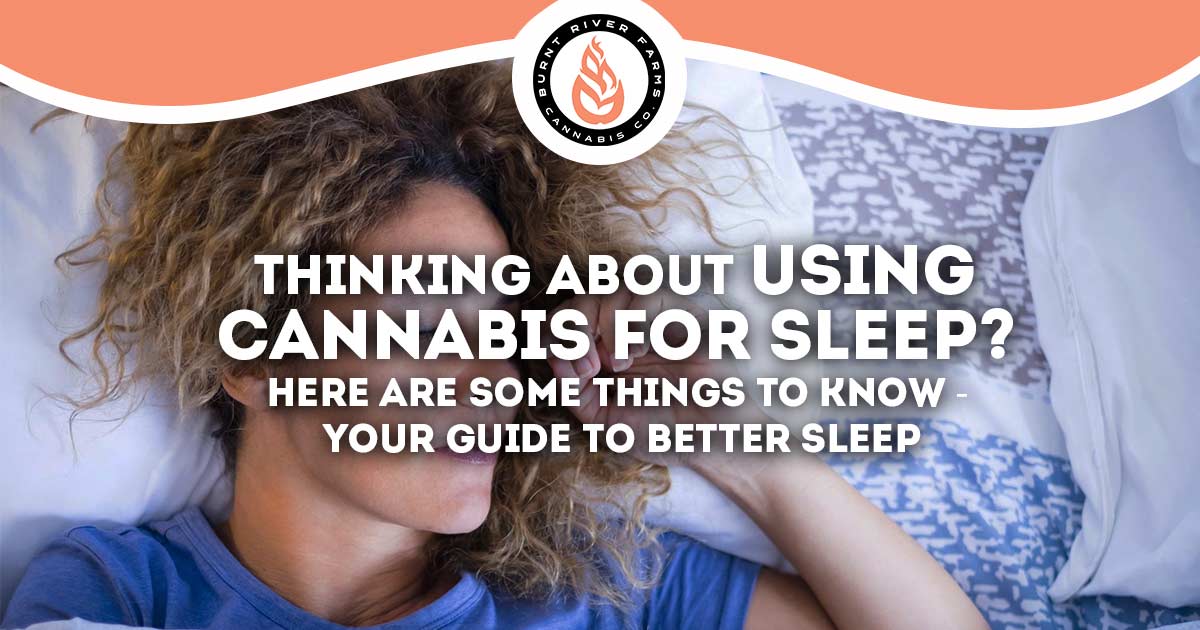Thinking About Using Cannabis for Sleep? Here Are Some Things to Know - Your Guide to Better Sleep

As cannabis grows in popularity, more people are turning to it to help them sleep and improve sleep quality. Today, we’re going to share some information that will help you understand how cannabis affects natural sleep and can improve a number of sleep-related problems. Then you can decide if you’d like to consult with your doctor about using cannabis for sleep benefits instead of other prescription drug options.
Cannabis Helps Insomnia and Other Sleep Problems
Cannabis has been used as a sleep aid for centuries. It’s no wonder that so many people turn to it now to help with their sleep issues. Research has shown that cannabis can provide a relaxing, sedative effect on sleep. Naturally, being relaxed and under the influence of a mild sedative makes falling asleep much easier.
A recent study indicates that using cannabis can shorten the time it takes to fall asleep for individuals who have sleep problems, as well as those who don’t. For those who do have insomnia or difficulty falling asleep, cannabis use helped patients fall asleep 30 minutes earlier on average. Those who did not have a history of insomnia or difficulty falling asleep still fell asleep approximately 15 minutes faster on average.
Not only does cannabis seem to shorten how long it takes for people to fall asleep, but it also helps them spend more time in a deep, slow-wave state of sleep. This is the level of sleep believed to be the most restorative sleep stage. It also plays a very important role when it comes to daytime functioning and brain health. Since more time is spent in slow-wave sleep, less time is spent in REM sleep. Researchers believe that this is a result of the primary active ingredient in cannabis, THC or tetrahydrocannabinol.
Cannabis Contains Many Different Natural Chemicals that Affect Sleep
While cannabis contains dozens of natural chemicals that impact sleep and sleep cycles, there are two primary players. These are cannabinoids and terpenes.
The cannabis plant and different strains of cannabis have over 100 different cannabinoids. Scientists are researching these cannabinoids to find out exactly how they impact sleep, depression, anxiety, Alzheimer’s, Parkinson’s, seizures, cancers, and even reoccurring chronic pain. The three most well-known cannabinoids all have some effect on sleep.
CBD
One of the most commonly recognized chemical compounds found in the cannabis plant is CBD or cannabidiol. CBD does not cause mind-altering effects, but it does still help with relaxation. CBD is a great option for those who wish to enjoy many of the benefits of cannabis but without the “high” feeling. Many people have turned to CBD as a means of reducing anxiety, chronic pain and physical pain while also helping mental clarity and focus. It also can promote daytime alertness and reduce anxiety without having a negative impact on the typical sleep-wake cycle.
CBN
A cannabinoid just emerging into the spotlight is CBN or cannabinol. CBN has been shown to have a more potent sedative effect which is only enhanced when combined with its THC counterpart. Like CBD, CBN also has similar properties for relieving pain and inflammation. However, CBN tends to increase appetite while CBD suppresses it. Over time, the THC in cannabis slowly converts to CBN.
THC
THC is probably the most well-known of all cannabinoids. It is the primary psychoactive chemical found in cannabis. THC is what causes the high commonly associated with cannabis use. However, THC also offers pain relief, reduces nausea, and has sedative effects. Not only does THC make it easier to fall asleep and provide better sleep quality, but there is some evidence that may suggest it can even improve breathing during sleep. More research is needed to fully understand how THC and nighttime breathing interact, but this could be groundbreaking information when it comes to the treatment of a common and dangerous sleep disorder, obstructive sleep apnea.
Time Spent in REM Sleep
When it comes to sleep, THC has been found to help the patients spend less time in REM sleep and more in slow-wave sleep. This means there is often less dreaming taking place while using cannabis. This is very helpful to those who experience disturbing nightmares or suffer from PTSD. Though after stopping cannabis or THC use, it is common to experience a burst of dreams called REM rebound.
It is important to consider how long you should use cannabis as all sleep cycles are important for healthy rest for both the mind and body, as well as brain function. Long-term changes could have long-term consequences as our bodies are designed to rely on all levels of sleep. It’s important to speak with a medical professional before making any decisions on cannabis self-medication.
Terpenes
While the different cannabinoids seem to hog a lot of the spotlight for their numerous health benefits, terpenes also play a significant role. Scientists are still learning about terpenes and how they affect sleep as well as your mind and body. However, the working theory is that they enhance the effects of the different cannabinoids.
Terpenes are very small, aromatic molecules found in cannabis. They’re what creates the unique smell and taste. However, they’re not only found in cannabis. In fact, they’re in a large variety of flowers, fruits, and plants. To date, scientists have discovered over 150 types of terpenes. Research has shown that these terpenes can impact mood, energy, drowsiness, and alertness.
Different Types of Cannabis have Different Types and Amounts of Cannabinoids and Terpenes
It is always best if you consult your doctor before you make any changes to medications or supplements. But you can use this information to help start a conversation with your medical care provider.
There are many types of cannabis and for the beginner, choosing one to start with can feel very overwhelming. There are a variety of strains available, and they have different effects on the mind and body. However, working with your medical provider and an excellent dispensary makes the decision much easier.
There are two primary strains of cannabis, called Indica and Sativa. You can also find a variety of hybrid strains. If you’re looking for something to help you relax and sleep then you may want to consider Indica. If you’re looking for something more invigorating or energizing, Sativa may be a better choice for you. However, these are generalizations, and they may not always be accurate. Your best source of information is from a knowledgeable person at a high-quality dispensary. They may be able to provide you with a strain that better meets your needs. Just don’t be afraid to ask questions.
Know Potential Side Effects of Cannabis for Sleep Use
Like anything, cannabis does have side effects you should be aware of. They can include:
- Dry mouth
- Euphoria
- Increased appetite
- Next-day grogginess
If you use cannabis for an extended period of time, then you may also experience some withdrawal symptoms which could result in changes to your mood such as feelings of depression or anxiety. You may also experience changes to sleep such as difficulty falling asleep, or the vivid dreams associated with REM rebound.
Where You Live Affects How You Can Use Cannabis
State laws regarding legal cannabis for both medical and recreational use change often. Even if you live in a state where cannabis is legal without a prescription, it’s a good idea to talk to your doctor about medicinal cannabis, cannabis and sleep, just as you would if you were adding, stopping, or changing any medication or supplement regimen.
There are also different ways to use cannabis and its benefits for sleep. You can smoke it, use a tincture, vape, or even eat it in edibles. Each method of consumption comes with its own dosing suggestions and your doctor may have dosing recommendations as well.
